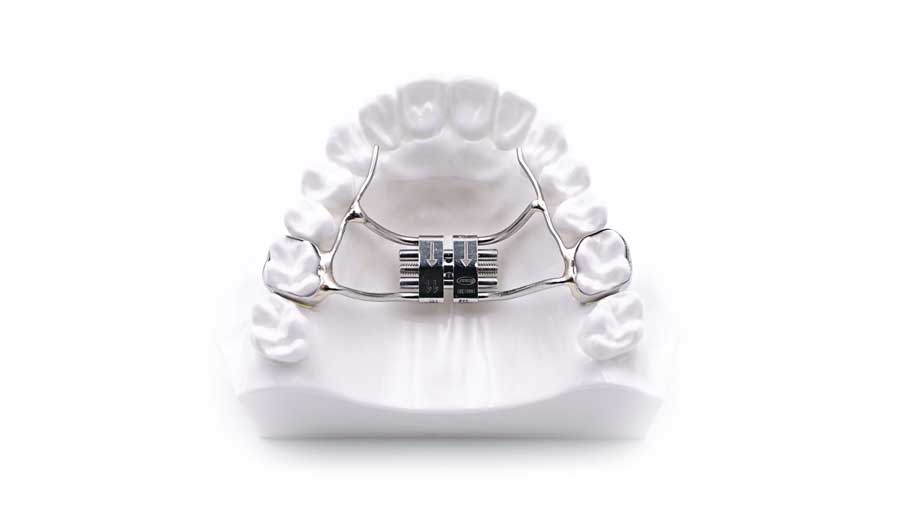If your child needs the roof of their mouth widened to treat their specific orthodontic issue, your specialist orthodontist might recommend a palatal expander.
But what is a palatal expander? And how long do they need to wear one for? Read on to discover the answers to all your palatal expander questions (and more!).
What is a palatal expander?
A palatal expander is an orthodontic appliance that helps widen your upper jaw (also known as the maxilla). It is mainly used for correcting the posterior dental cross bite, relieving dental crowding, widening the smile arc, and widening the floor of the nasal cavity to improve the nasal airflow.
A palatal expander can be used on its own, or in combination with other orthodontic appliances such as braces, functional appliances, or headgear.
There are two types of palatal expanders – fixed expander (glued to teeth), and removable expander. Your orthodontist will choose the type of expander that is most suitable for the patient. All expanders are custom-made by taking an impression of the mouth or by doing a digital scan.
Do palatal expanders work for adults?
Palatal expanders do not work as well for adults when compared to children or teenagers. This is because the bone junctions surrounding the upper jaw fuses and calcifies as a child grows older. Once these junctions are fused and completely calcified, the upper jaw can no longer be expanded. So it is always best to have palatal expander treatment early.
The most common age for palatal expander treatment is from 8 to about 15 years old. For adult treatment, if the amount of expansion is small, then palatal expander may also work. If the amount of expansion is significant (such as correction of posterior crossbite), then palatal expansion combined with jaw surgery will be required. It is best to have an Orthodontic assessment by age 8 to see if expansion or any early interceptive treatment to avoid problems may be required.

Are palatal expanders really necessary?
If there is an upper and lower jaw size discrepancy, then palatal expander treatment is necessary. Having a narrow upper jaw can cause lasting bite problems and impact physical appearance. Because of this, general dentists are trained to identify signs of narrow upper jaw early so a prompt referral can be made to a specialist orthodontist. However, because no referral is required to see an orthodontist in Australia, you can also ask an Orthodontist to check your child and whether they have a narrow upper jaw.
Once the diagnosis of narrow upper jaw has been confirmed, orthodontists will generally advise upper palatal expander treatment – especially in children or young adolescents. Having a palatal expander becomes more difficult the older you get, so it’s best to get started right away. It is best to have an Orthodontic assessment by age 8 to spot any future issues early.
How long do palatal expanders stay in?
Depending on the type of palatal expander used and the severity of the problem, the treatment can range from three to 12 months. Like any orthodontic treatment, once the expander is removed, your orthodontist may recommend wearing a retainer to maintain the expansion until the upper jaw expansion has stabilised.
Benefits of Palatal Expanders
Expanding your upper jaw can have a positive impact on your life, which can include:
- More room for your adult teeth
- More comfortable and healthier bite
- Correcting posterior dental crossbite
- Correcting overbite and underbite (in combination with other orthodontic appliances)
- Relief of mild to moderate dental crowding
- Widening of the smile arc
- Improving airflow through nasal cavity

What are the side effects of palatal expanders?
Because their mouth is getting used to a foreign object, there may be some initial side effects after installing a palatal expander. If your child experiences any of the listed side effects, don’t worry – they’re normal and only temporary, but get in touch with your orthodontist if they persist:
- Extra saliva: The expander will cause their mouth to produce more saliva, which will take a couple of days to get used to.
- Inhibited speaking: Naturally, their speaking will be slightly affected by the installation of the expander. Just like the saliva, they will have conquered this in a few days.
- Excess food debris: Like their teeth, the expander is another place where food can build up. It’s common for this to happen between the expander and the roof of the mouth. Combat this with diligent dental hygiene.
- Gap tooth: Expanding the jaw can create spaces between their upper front teeth. However, they’ll only have this quirk for a short while, as the gap will start to close naturally before the treatment is over.
- Discomfort: Like any orthodontic appliance, there will be short term discomfort after installing the palatal expander. This can be irritation to their cheeks and tongue, sensitive teeth, mild toothache, or mild jaw joint ache. The discomfort will disappear in a couple of weeks once they get used to the palatal expander.
Can you have expanders and braces at the same time?
While an expander is usually done before braces, it is possible that you could have both at the same time. Plus, it is perfectly safe to have both. Your orthodontist will be simultaneously correcting jaw discrepancy and teeth alignment, so having both at the same time might help reduce the total treatment time.

Does palatal expander change face shape?
Having a palatal expander will not make your face wider. However, if they have facial asymmetry associated with posterior dental cross bite, then palatal expander can improve your facial asymmetry. Expanding the upper jaw will correct your jaw to the way it was meant to be and have it looking the way it was meant to look.
Want to get started?
Use our Finder Tool to search for a local specialist orthodontist near you they’ll be happy to give personalised advice on any of palatal expanders, braces and more. A referral is not needed to see an Orthodontist in Australia.










My 15 year old son has overbite and extremely crowded teeth
Will expander help with this issue?
Hi Smitha,
An expander can help make some space for crowded teeth but it is not suitable for all situations. It would be best to consult a specialist Orthodontist who will make an assessment of the degree of crowding while also considering many other factors including lip support, facial profile, narrowness of the palate, health of supporting bone and gums, and sixe of teeth.
To find an orthodontist near you please use our Finder Tool
Thanks!